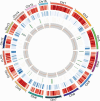Chromosome-level genome assembly of the Rhizoctonia solani
- PMID: 40544159
- PMCID: PMC12182583
- DOI: 10.1038/s41597-025-05351-8
Chromosome-level genome assembly of the Rhizoctonia solani
Abstract
Rhizoctonia solani is a ubiquitously distributed soil-borne fungal pathogen that causes serious diseases in many plants worldwide. It attracts significant research attention due to its considerable economic importance in agricultural production. However, the limited availability of genome information has further impeded the development of new molecular-targeted control technologies. By utilizing Illumina short-read, PacBio HiFi long-read, and high-throughput chromosome conformation capture (Hi-C) sequencing technologies, we present a comprehensive and continuous chromosome-level assembly for R. solani. The final genome size is 40,801,261 bp, consisting of 23 contigs with a N50 of 2,529,230 bp. Hi-C data aids in anchoring the assembly onto 16 chromosomes. Additionally, the genome contains 16.17% (6,597,897 bp) repeat elements, including 10,698 protein-coding genes and 232 non-coding RNAs. The high-quality genome of R. solani not only provides valuable genomic information for further comprehending the fungal pathobiology and evolution, but also contributes to the development of scientific control strategies for disease prevention and control in agriculture.
© 2025. The Author(s).
Conflict of interest statement
Competing interests: The authors declare no competing interests.
Figures



References
MeSH terms
Supplementary concepts
Grants and funding
LinkOut - more resources
Full Text Sources

